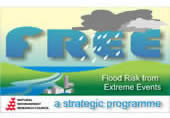Project

FREE - Local flood forecasting capability for fluvial and estuarine floods: Use of GridStix for constraining uncertainty in predictive models
Abstract
The Local flood forecasting capability for fluvial and estuarine floods: Use of GridStix for constraining uncertainty in predictive models Project is a NERC Flood Risk for Extreme Events (FREE) Research Programme project (Round 1 - NE/E002439/1 - Duration October 2007 - October 2009) led by Prof Keith Beven, Lancaster University. The data and metadata from this project will be stored at the NERC Centre for Ecology and Hydrology.
Details
| Keywords: | Not defined |
|---|---|
| Previously used record identifiers: |
http://badc.nerc.ac.uk/view/badc.nerc.ac.uk__ATOM__ACTIVITY_a08ac804-42e7-11e1-be2d-00163e251233
http://badc.nerc.ac.uk/view/badc.nerc.ac.uk__ATOM__dataent_1227540709626907
|
More Information (under review)
This project aims to make use of lots of networked GridStix depth sensors to improve predictions of flood inundation and water level elevation at important locations with a view to improving flood warning capabilities. The project involves improving the software that links the sensors and distributed computing resources. This will allow distributed hydraulic routing models to be run, with the possibility of reducing the uncertainty in their predictions by using the sensor information in real-time. Since the GridStix also have on-board computing capabilities there is also a possibility of building a cheap local forecasting system for specific points at risk of flooding. The science questions involved include how best to make the netwroking robust, how best to constrain the uncertainty in flood routing models and improve their predictions, and how best to implement the local flood forecasting models. The research will be implemented on the River Ribble, subject to regular fluvial flooding, and the tidal system of the River Dee Estuary. The research represents a collaboration between Lancaster and Bristol Universities, the Proudman Oceanographic Laboratory and the Environment Agency.
Project Duration: October 2007 - October 2009.
This project is funded by NERC - Grant Ref. NE/E002439/1 - through the Flood Risk for Extreme Events (FREE) NERC directed mode programme.
This project aims to develop and improve models that predict flood inundation and water elevation level which will include incorporating data from a network of GridStix sensors that measure river depth in real time.
GridStix are an instrument developed by the Lancaster team that record a time-series of depths every 15 minutes. This data is currently stored in plain ASCII format at Lancaster but not in a NERC data centre. Past and present data from GridStix will be archived at CEH and advice on formatting into a standard supported format will be offered by BADC. This data would then also be available to the wider community.
Other data for the Ribble and Dee areas were collated for use during this project including airborne LiDAR from the Environment Agency (for data requests see Environment Agency Geomatics Group pages, sonar bathymetry, river and tidal gauges, flood defence assets, ordinance maps and satellite images (Synthetic Aperture Radar Imagery from ESA). This data, collected from the Environment Agency, Proudman Oceanographic Laboratory (POL) and the NERC ARSF aircraft will be archived at BADC and BODC as appropriate where permitted by the data supplier. Relevant references describing collated data from variety of sources assembled for Ribles and Dee sites are available in the "Links and references" section below.
Links
- CEH website - http://www.ceh.ac.uk/
- BODC website - http://www.bodc.ac.uk/
References
- Schumann, G., Di Baldassarre, G. and Bates, P.D. (2009). The utility of spaceborne radar to render flood inundation maps based on multialgorithm
ensembles. IEEE Transactions on Geoscience and Remote Sensing, 47(8), 2801-2807, doi: 10.1109/TGRS.2009.2017937
- Di Baldassarre, G., Schumann, G. and Bates, P.D. (2009). A technique for the calibration of hydraulic models using uncertain satellite observations of
flood extent. Journal of Hydrology, 367, 276-282, doi: 10.1016/j.jhydrol.2009.01.020
- P. Smith, K.Beven, W.Tych, D.Hughes and G.Blair (2008), A step towards detailed local flood warnings - The GridStix project., Geophys. Res. Abstracts, 10,EGU2008-A-07196
- Hughes, David and Greenwood, P. and Coulson, G. and Blair, G. S. and Pappenberger, F. and Smith, P. and Beven, Keith J. (2006), GridStix : supporting flood prediction using embedded hardware and next generation grid middleware. In: Proceedings of the 4th IEEE International Workshop on Mobile Distributed Computing (MDC 2006).
- List of projects funded under the FREE programme.
- FREE Science Plan
- FREE Implementation Plan (January 2008)
- FREE Progress Report (May 2008)
- FREE Progress Report (Oct 2008)
- Data Inputs to FREE projects
This FREE project is headed by Prof Keith Beven of Lancaster University, with co-investigators at Lancaster University, the Proudman Oceanographic Laboratory and the University of Bristol.
General queries about these pages should be directed to the BADC support line.
Related Documents
| FREE Website |
| FREE GridStix grant details |
| NERC FREE webpage |
| Other FREE projects |
